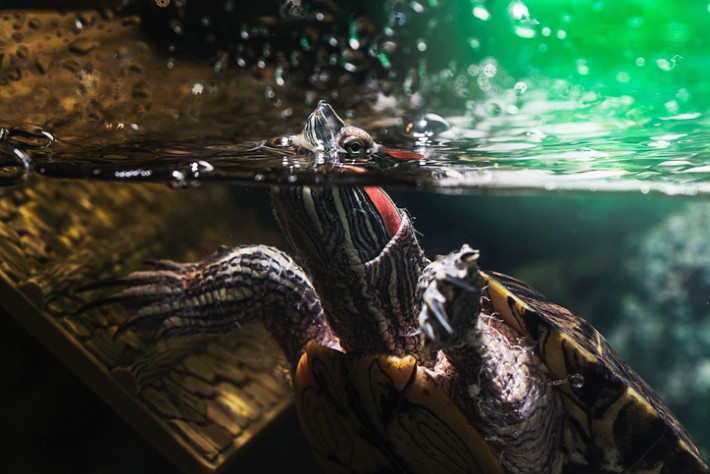Focus on Turtles: Your Questions Answered

If you are thinking of getting a pet turtle, be ready for the responsibilities and know it’s one you are going to have for a long time.
That said, turtles make great pets. They are good for families who are allergic to dogs or cats. They don’t require as much attention or grooming as dogs or cats, and they are certainly more interactive than fish. They particularly make good pets for children, especially in a classroom setting (specifically middle school and over, younger classrooms should not have turtles in class), because they teach responsibility. However, not just anyone should keep a turtle as a pet. And if you are here, it because you have questions about how to do so. But, the biggest question is:
Should I keep a Turtle as a Pet?
A turtle is a long-term commitment. One that could last 15 to 25 years (turtles live that long). So, if you are getting one, be sure it’s one you want to keep. A turtle is not as active as a dog, cat, or bird. Most owners realize this a few weeks or a month in and then decide to give it away. Another issue is, when most people buy a pet turtle, they usually come as small cute creatures. But they can grow big, usually bigger than their small aquarium, and unless the owner is committed to keeping it, their usual instinct is to release it and this can be bad for the turtle. So, before you get one, you should:
Know the Species You Want
As mentioned earlier, different species grow to different sizes – some turtles, especially females can grow very large. They grow much larger than the male turtles. So, if you want your turtle to stay cute and small for a long time, don’t get the female ones. As a beginner, the best ones to go for are the male-painted turtles.
Be Health Cautious
Turtles, even though seemingly clean and healthy, can carry salmonella germs in their droppings. And this can easily spread to their bodies and habitat. A person can get infected after touching the body of the turtle. Those at the highest risk are little children, pregnant women, the elderly, and anyone with a poor immune system. So, be particular about good hygiene. Keep children from having direct contact and wash your hands thoroughly after you do.
Regardless of these, turtles make great pets. They can be your companion for life, are relatively easy to take care of, and require minimal space.
How can I Set up a Home for My Turtle?
When setting up a home for your turtle, you are going to need:
Aquarium
Turtles are strong swimmers, so they need a place with enough water where they can swim. Get a big tank, the kinds designed to hold water. The bigger the tank, the more space the turtle has to swim. Of course, it should be a glass tank. You can fill the tank up with water, using a bucket or a hose. Make sure the water is clean, drinking water. The Aquarium should also have a screened lead and a filter. The filter will be used to clean the water so that you don’t have to change the water every few days. You should also create a basking area. This is a place where the turtle can sit and sun itself. A basking area is very important to the turtle’s health and survival.
Proper Heat and Lighting
You need to keep the water in the tank and the surrounding habitat at the correct temperature range. So get two thermometers. One to measure the temperature of the water and the other to measure the temperature of the air around the habitat. You can use an underwater heater to maintain the temperature in the tank, and you can hang a heat bulb over the dry side of the habitat to keep the temperature steady. At any given time, the temperature in the water should be around 72 to 77 degrees and the temperature in the basking area should be around 85 to 90 degrees.
What do I Feed My Turtle?
What your turtle eats depends on its species. There are over 300 species of turtles, and they all have different dietary needs. So, depending on the species of the turtle, it could be:
- Carnivorous: These eat only meat.
- Herbivorous: These eat only plants and vegetables.
- Omnivorous: These eat both meat and plants.
If you are confused about what to feed your turtle, consult a vet or simply ask the pet store you are buying it from. Most pet stores have a variety of food for different species of turtles. These foods come with the nutrition your pet needs to stay healthy so, you will find the one your pet needs.
However, if your turtle falls between these categories, (aquatic and land), you can feed them:
- Aquatic Turtles: Will eat crayfish, spiders, crickets, and snails.
- Land Turtles: Will eat fruits, cacti, wildflowers, and grass.
You can also feed your turtle fresh foods like eggs (boiled), snails, earthworms, corn, carrots, peas, yam, lettuce, beets, cantaloupe, mangoes, bananas, strawberries, tomato. These foods should depend on the turtle’s species. Also, note that you need a variety of foods to keep your turtle strong.
Don’t feed your turtle:
- Raw meat.
- Manufactured food like bread or biscuits. These foods have different ingredients and they may not be good for your turtle’s health.
- Dairy products like milk or cheese. Turtles cannot digest them.
How can I keep My Turtle Healthy?
This depends on how you treat it and feed it. As mentioned earlier, a turtle needs a big tank, with lots of clean water. A small tank will restrict your turtle from swimming as much as it wants and this will only lead to stress. A stressed turtle is one that is more likely to be sick. Also, the tank should be large, but not so large that the turtle has trouble finding its food.
Another way to keep your turtle healthy is to install UV lights in its habitat. UV lights aid calcium absorption, which is great for growing turtles and equally necessary for aging turtles. You also want to be observant. When turtles get sick, they can hide their symptoms until it gets worse. So, if you notice your turtle is hiding most of the time, losing weight, having a discharge from its eyes, nose, or mouth, has swollen joints or skin discoloration then take it to a vet.
Also, when lifting your turtle, lift from its midsection and not from the legs.
